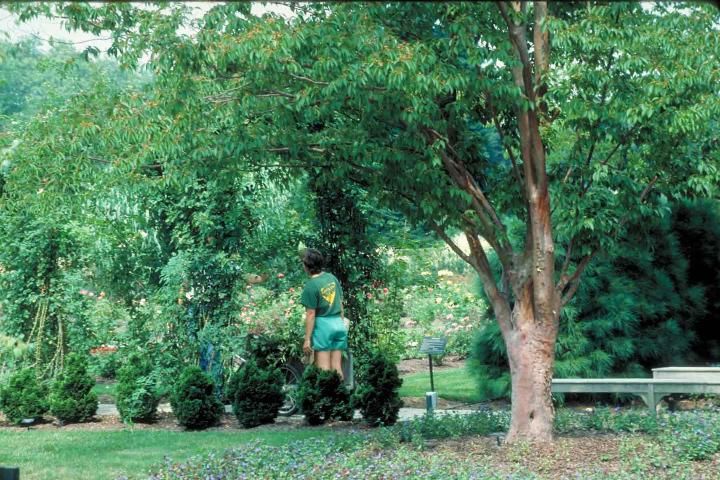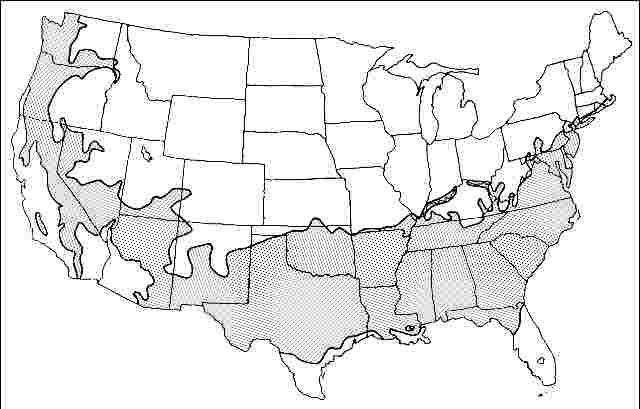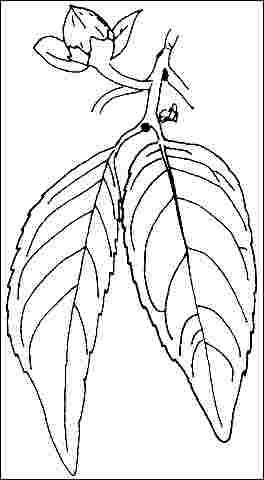Introduction
Tall stewartia grows 20 to 25 feet in height in as many years though it has been known to reach 80 feet, its young pyramidal crown maturing into an open, multi-trunked form with somewhat horizontal branches. The 1.5- to 2.5-inch-long dark green leaves cast light shade below this deciduous tree, and cling well into the fall after changing to an attractive deep red. In June the small, white, cupped flowers appear, opening over a four-week period but are not particularly striking. The smooth cinnamon-brown bark is outstanding and help to make tall stewartia quite striking in the winter landscape.

Credit: Ed Gilman, UF/IFAS
General Information
Scientific name: Stewartia monadelpha
Pronunciation: stoo-AR-tee-uh mawn-uh-DELL-fuh
Common name(s): Tall stewartia
Family: Theaceae
USDA hardiness zones: 6B through 8B (Fig. 2)
Origin: not native to North America
Invasive potential: little invasive potential
Uses: specimen; deck or patio; street without sidewalk; container or planter; espalier; parking lot island 100-200 sq ft; parking lot island > 200 sq ft; sidewalk cutout (tree pit); tree lawn 3-4 feet wide; tree lawn 4-6 feet wide; tree lawn > 6 ft wide; highway median
Availability: not native to North America

Description
Height: 20 to 25 feet
Spread: 15 to 25 feet
Crown uniformity: symmetrical
Crown shape: pyramidal, vase
Crown density: open
Growth rate: slow
Texture: medium
Foliage
Leaf arrangement: alternate (Fig. 3)
Leaf type: simple
Leaf margin: serrate
Leaf shape: ovate, elliptic (oval)
Leaf venation: pinnate, brachidodrome
Leaf type and persistence: deciduous
Leaf blade length: less than 2 inches, 2 to 4 inches
Leaf color: green
Fall color: red
Fall characteristic: showy

Flower
Flower color: white/cream/gray
Flower characteristics: showy
Fruit
Fruit shape: oval, round
Fruit length: .5 to 1 inch
Fruit covering: dry or hard
Fruit color: unknown
Fruit characteristics: does not attract wildlife; not showy; fruit/leaves not a litter problem
Trunk and Branches
Trunk/bark/branches: branches don't droop; very showy; can be trained to one trunk; thorns
Pruning requirement: little required
Breakage: resistant
Current year twig color: green, gray
Current year twig thickness: thin
Wood specific gravity: unknown
Culture
Light requirement: full sun, partial sun, or partial shade
Soil tolerances: clay; sand; loam; acidic; well-drained
Drought tolerance: high
Aerosol salt tolerance: unknown
Other
Roots: not a problem
Winter interest: yes
Outstanding tree: yes
Ozone sensitivity: unknown
Verticillium wilt susceptibility: unknown
Pest resistance: free of serious pests and diseases
Use and Management
This tree can be used in much the same way as Japanese stewartia. It is unsurpassed as a specimen, but can also be included in a shrub border, planted near a patio or deck to show off the wonderful bark, or used as a multi-trunked street tree planted on 20-foot centers. Set it off as a specimen by placing it in a bed of low, evergreen ground cover.
Best when grown in partial shade in USDA hardiness zone 8b, tall stewartia can tolerate a full sun position if its roots can be shaded by ground cover, mulch or shrubbery. This may be the best Stewartia species for the deep south. Stewartia monadelpha is a native species well-suited for the deep south. Well-drained, acid to neutral soil is best.
Propagation is by seed or cuttings.
Pests and Diseases
No pests or diseases of major concern, and this tree should be grown and planted more often.